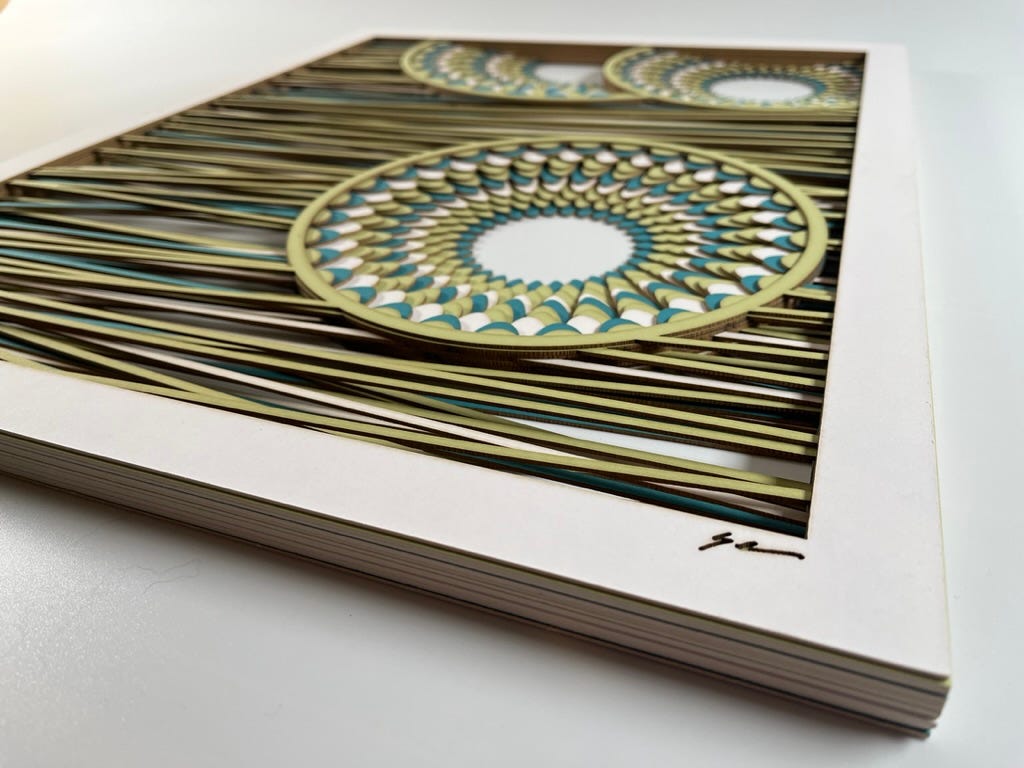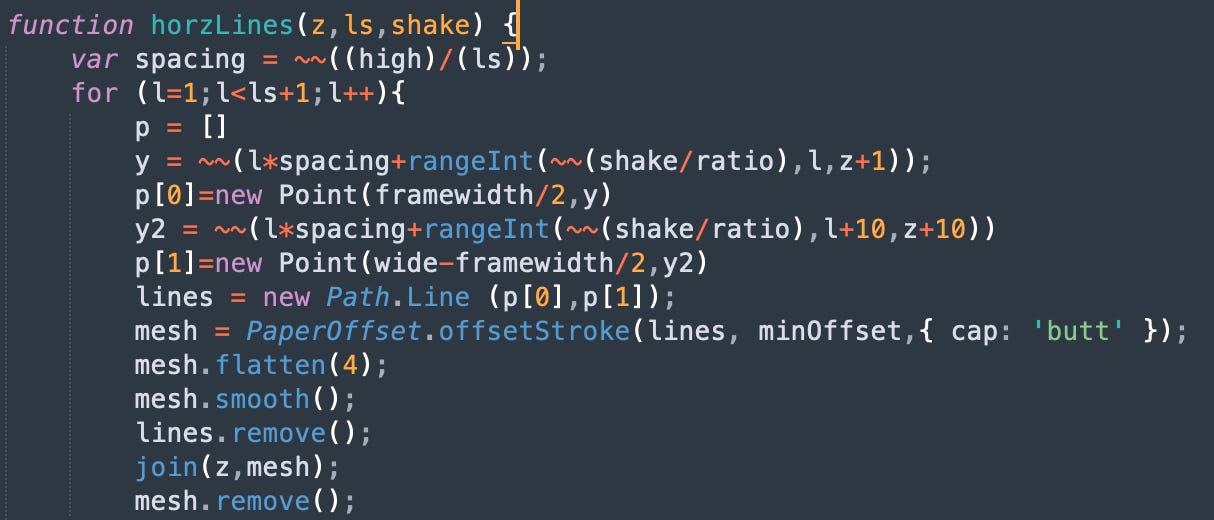Generative art for the real world
Blueprints for bringing delight and joy into places we live & work.
Generative art is having a moment, while it’s been around for decades it’s popularity has soared in recent years due to new technologies and marketplaces. This has opened up a massive new art market that in 2022 saw over $1.5B in primary and secondary sales of digital generative outputs.
Unlike traditional art and photography where there is a single composition that is reproduced, in generative art there is the potential for a single project to have billions of unique outputs.
There are two primary forms of generative art: Algorithmic and AI. For the purposes of this article we are going to focus primarily on the algorithmic style which uses code created by an artist to generate outputs based on deterministic randomness.
In the traditional art world we tended to see three primary forms of editions
Originals - This is the original painting or sketch that was created by the artist. Only one of it will ever exist and was created by the artist. Usually signed and with a certificate of authenticity.
Limited - A finite series of reproductions of the original approved by the artist. These are usually signed and numbered.
Open - A series of mass reproductions, usually lower cost, that is limited only by demand. Often sold as prints at retail stores or as merchandise such as stickers, clothing, or housewares.
But with generative art there are a few more variables to consider.
The artist often isn’t directly producing the output. Instead the artist is creating a set of instructions that utilize random variables to create a unique and distinct digital output each time it’s run. This is usually deterministic meaning it is provided with a seed value that will produce the same output each time it’s run given the same seed value.
This instruction set or algorithm is then used to produce artworks.
Sometimes this is provided directly to collectors and they get to be part of the process of running it, being the first to see an output, and then collect it. This is known as long form generative art and requires a more complicated algorithm that can reliably create thousands of high quality and distinctly unique outputs every time it’s run.
Other times the artist uses the script themselves to run through thousands of outputs and selects only a few that meet their standards and vision for the project. This is usually called short form and the artist is much more hands on with tweaking variables until they get exactly the right output they want to add to the collection.
The outputs from these generative algorithms are a hash or seed that is unique and when plugged back into the script produces the same digital image each time, either pixel based such as a png or jpg or vector in the form of an svg. Which can be shared or downloaded.
For the purpose of physical manifestations these digital outputs are essentially a blueprint. A series of instructions that can be used to produce it in the physical world. Most commonly through printing it on paper, canvas, or metal panels. But also with other computer controlled tools such as pen plotters, laser cutters, embroidery, or 3D printers.
These digital outputs can either be owned or simply exist as saved outputs.
The most common way they are owned is to be minted as a non-fungible token (NFT) on a blockchain such as Ethereum or Tezos using a platform like ArtBlocks or fxhash. The project is given a finite number of possible outputs and each output is sequentially numbered and verifiably owned. These NFT’s can be resold and traded on various marketplaces with royalties flowing back to the artist. The provenance of this ownership is public and can be traced from artists to the original minter through the current token owner.
It's also possible to turn these digital blueprints into physical objects that extend the value into spaces in the real world. But there are a number of questions that have to be addressed.
If I own an NFT of a generative project can I use the output to print a copy myself? Can I print multiple copies? Can I sell those copies? Can I request a physical from the artist?
It’s important for a generative artist to define the rules they and others will follow as it relates to the ownership and limits on digital outputs & physical reproductions for a given project.
With that aim in mind here is a framework that links a generative art project with commonly understood art definitions.
Limited Edition - A finite number of exact physical reproductions may be produced for each output by the artist or a facility authorized by them.
Special Editions - A finite number of varied physical reproductions may be produced for each output by the artist or a facility authorized by them. These reproductions may vary in size, color, and material. (ex: 8x10 or 16x20 canvas or metal prints)
Open Editions - An unlimited number of physical reproductions may be produced for each output by the artist or a facility authorized by them. These reproductions may vary in size or color or product usage. (ex: Posters, stickers, coffee mugs, book cover, wallpaper, fabric)
In addition to these categories a physical may also have the following additional characteristics.
Signed - Physicals that the artist themselves have hand signed and/or numbered.
Artist Proofs (AP) - Outputs from a generative script that are in addition to a defined mint size. These are not part of the project series and are “owned” by the artist for the purposes of marketing or creation of physicals.
Commissionable - Physical iterations can be requested directly from the artist by anyone who can verify they own a digital output from the project.
Personal - Token owners can have copies made at a facility of their choosing for personal use as long as they do not sell or use them in commercial applications.
Let’s look at some specific examples of how this framework might play out.
Say you are an artist and attending an art show, you might have 500 postcards printed up of a non-minted output from one of your projects to hand out to fans. This would be called an Open Edition Artist's Proof or OEAP. Some of these might even get signed if people ask.
Maybe you’ve collected an NFT for a generative project on fxhash and the artist has defined that it has up to 5 commissionable Limited Edition signed physicals. As the token owner you have the option to purchase one of these physicals from the artist until they have all been sold.
An artist has carefully curated a single output and turned it into an NFT with 500 owners and defined that any token owner can print as many Open Edition physical prints as they want for their personal use or as gifts but cannot sell them or use them in commercial applications.
The goal is to clear up confusion and make it much easier and explicit for people to understand what they are purchasing as it relates to the physical manifestations of a generative artwork.
In most cases a physical manifestation, once it’s created, is mostly disconnected from the generative script and the digital output. Over time someone may own the NFT and someone else may own one of the physical objects that was created using that output as a blueprint.
As a generative artist whose artwork is designed to exist as physicals here is how I am currently thinking about using this framework in my practice.
I’ll create a project which consists of a generative script. Each new project borrows and builds on previous code but has a distinctly different theme. Those scripts will be placed on a generative minting platform such as fxhash and limited to a few hundred outputs. Owners of those NFT’s will be able to commission special edition signed physicals from me.
I’ll also pick a few of the outputs I feel best represent the vision I had for the project, these will become part of a limited edition physical collection that will be available for anyone to purchase on marketplaces like Etsy and Wescover. The person who originally minted a curated physical will also get a mention as co-creator of the series. I’ll probably also generate a few special unnumbered artist proof outputs as well to include in the curated collection of publicly available physical artworks.
I might even surprise token owners who’s curated physicals are selling well by giving them coupons for free or discounted physical editions and reserve spot on future minting releases. So that their investment in the digital blueprint and their sharing of the physical editions with friends is rewarded over time.
It’s exciting times as this new medium matures and a vibrant community of generative artists work together to add value and create new experiences for creating, owning, and sharing these new forms of art with the world.



